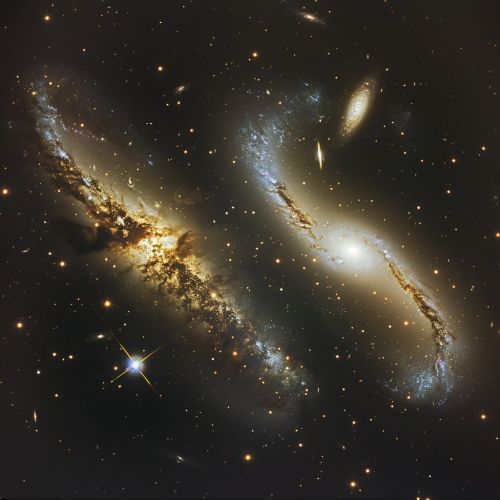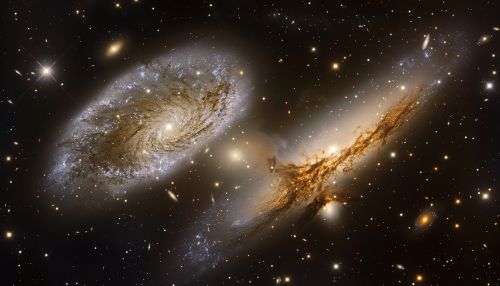Galaxy merger
Galaxy Merger
A galaxy merger is a process in which two or more galaxies collide and coalesce to form a single, larger galaxy. This phenomenon is a fundamental aspect of galaxy evolution and plays a critical role in shaping the structure and dynamics of the universe. Galaxy mergers can result in significant changes in the morphology, star formation rates, and overall dynamics of the involved galaxies.


Types of Galaxy Mergers
Galaxy mergers are generally classified into two main types based on the masses of the interacting galaxies: major mergers and minor mergers.
Major Mergers
A major merger occurs when two galaxies of comparable mass collide. These events are often violent and can lead to the formation of elliptical galaxies. The gravitational interactions during a major merger can trigger intense starburst activity, leading to the rapid formation of new stars. Major mergers can also result in the redistribution of gas, dust, and stars, significantly altering the morphology of the galaxies involved.
Minor Mergers
Minor mergers involve a larger galaxy merging with a significantly smaller one. These interactions are less disruptive than major mergers but still have substantial effects on the larger galaxy. The smaller galaxy is often absorbed by the larger one, contributing its stars and gas to the larger galaxy's structure. Minor mergers can lead to the formation of stellar streams and shell structures as the smaller galaxy is tidally disrupted.
Dynamics of Galaxy Mergers
The dynamics of galaxy mergers are governed by gravitational interactions. As galaxies approach each other, their mutual gravitational attraction causes them to accelerate towards one another. During the initial stages of the merger, tidal forces distort the shapes of the galaxies, creating features such as tidal tails and bridges.
Tidal Forces
Tidal forces play a crucial role in galaxy mergers. These forces arise due to the differential gravitational pull experienced by different parts of the galaxies. Tidal forces can strip stars and gas from the outer regions of the galaxies, forming tidal tails that extend far into space. These tails are often sites of active star formation due to the compression of gas.
Dynamical Friction
Dynamical friction is another important mechanism in galaxy mergers. It refers to the drag force experienced by a moving object (in this case, a galaxy) as it moves through a field of stars and dark matter. Dynamical friction causes the galaxies to lose kinetic energy and spiral towards each other, eventually leading to their coalescence.
Star Formation in Galaxy Mergers
Galaxy mergers are often associated with enhanced star formation activity. The gravitational interactions during a merger can compress gas clouds, triggering the collapse of these clouds and the formation of new stars. This process is known as a starburst. Starbursts can significantly increase the star formation rate (SFR) of the merging galaxies, sometimes by factors of ten or more.
Starburst Galaxies
Starburst galaxies are galaxies that are undergoing an exceptionally high rate of star formation. Many starburst galaxies are the result of galaxy mergers. The intense star formation in these galaxies can lead to the production of massive, short-lived stars that end their lives as supernovae. The energy released by these supernovae can drive powerful galactic winds that expel gas from the galaxy, potentially quenching further star formation.
Morphological Transformation
Galaxy mergers can lead to significant changes in the morphology of the involved galaxies. The final morphology of the merged galaxy depends on various factors, including the masses of the interacting galaxies, their initial morphologies, and the orbital parameters of the merger.
Formation of Elliptical Galaxies
Major mergers between spiral galaxies are believed to be a primary mechanism for the formation of elliptical galaxies. The violent relaxation process during the merger redistributes the stars into a more spherical or ellipsoidal configuration, resulting in an elliptical galaxy. The gas in the merging galaxies can be funneled towards the center, potentially fueling the growth of a supermassive black hole.
Disk Regrowth
In some cases, the merged galaxy can regrow a disk structure if sufficient gas remains after the merger. This process is known as disk regrowth. The gas can settle into a rotating disk, forming new stars and potentially leading to the formation of a new spiral galaxy. Disk regrowth is more likely to occur in minor mergers or in major mergers where a significant amount of gas is retained.
Role in Galaxy Evolution
Galaxy mergers are a fundamental aspect of galaxy evolution. They play a crucial role in shaping the properties and structures of galaxies over cosmic time. Mergers can drive the growth of galaxies, trigger star formation, and influence the distribution of dark matter.
Hierarchical Model of Galaxy Formation
The hierarchical model of galaxy formation posits that galaxies form and grow through a series of mergers and accretions. In this model, small protogalaxies merge to form larger galaxies, which can then undergo further mergers to become even more massive. This process of hierarchical merging is supported by observations of galaxy clusters and the large-scale structure of the universe.
Impact on Dark Matter Halos
Galaxy mergers also affect the distribution of dark matter. During a merger, the dark matter halos of the interacting galaxies can merge and form a single, more massive halo. The dynamics of dark matter during mergers are complex and can influence the overall gravitational potential of the merged galaxy.
Observational Evidence
Observational evidence for galaxy mergers comes from various sources, including optical and radio observations, as well as simulations.
Optical Observations
Optical observations of galaxies provide direct evidence of mergers. Features such as tidal tails, bridges, and disturbed morphologies are indicative of ongoing or recent mergers. Deep imaging surveys have revealed numerous examples of interacting galaxies at various stages of the merger process.
Radio Observations
Radio observations, particularly of neutral hydrogen (HI) gas, are also valuable for studying galaxy mergers. HI observations can trace the distribution and kinematics of gas in merging galaxies, providing insights into the dynamics of the merger. Radio observations have revealed extended HI tails and bridges in many interacting systems.
Simulations
Numerical simulations are a powerful tool for studying galaxy mergers. Simulations can model the complex gravitational interactions and hydrodynamics involved in mergers, providing detailed predictions of the resulting structures and dynamics. Simulations have been instrumental in understanding the formation of tidal features, the triggering of starbursts, and the morphological transformation of galaxies.
Future Research Directions
Research on galaxy mergers continues to be an active and evolving field. Future studies aim to address several key questions and challenges.
High-Redshift Mergers
One area of interest is the study of galaxy mergers at high redshifts (z > 1). High-redshift mergers provide insights into the early stages of galaxy formation and evolution. Observations with next-generation telescopes, such as the James Webb Space Telescope (JWST), are expected to shed light on the frequency and impact of mergers in the early universe.
Role of Environment
The role of the environment in galaxy mergers is another important topic. Galaxies in dense environments, such as galaxy clusters, may experience different merger rates and dynamics compared to those in less dense environments. Understanding the influence of environment on mergers is crucial for a comprehensive picture of galaxy evolution.
Multi-Wavelength Observations
Multi-wavelength observations, combining data from optical, radio, infrared, and X-ray telescopes, are essential for a complete understanding of galaxy mergers. Different wavelengths provide complementary information about the stars, gas, and dust in merging galaxies. Future multi-wavelength studies will help to unravel the complex processes involved in mergers.
